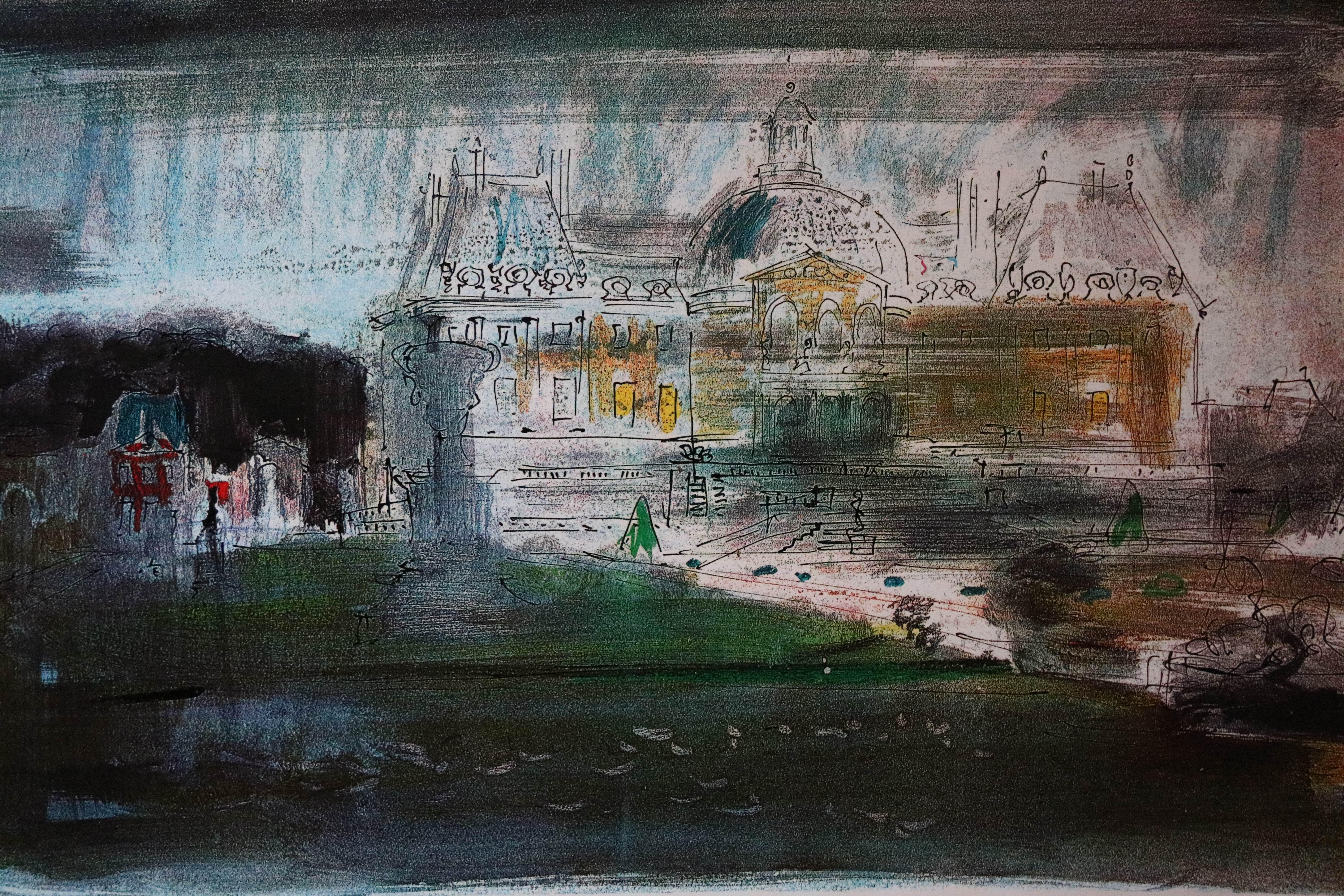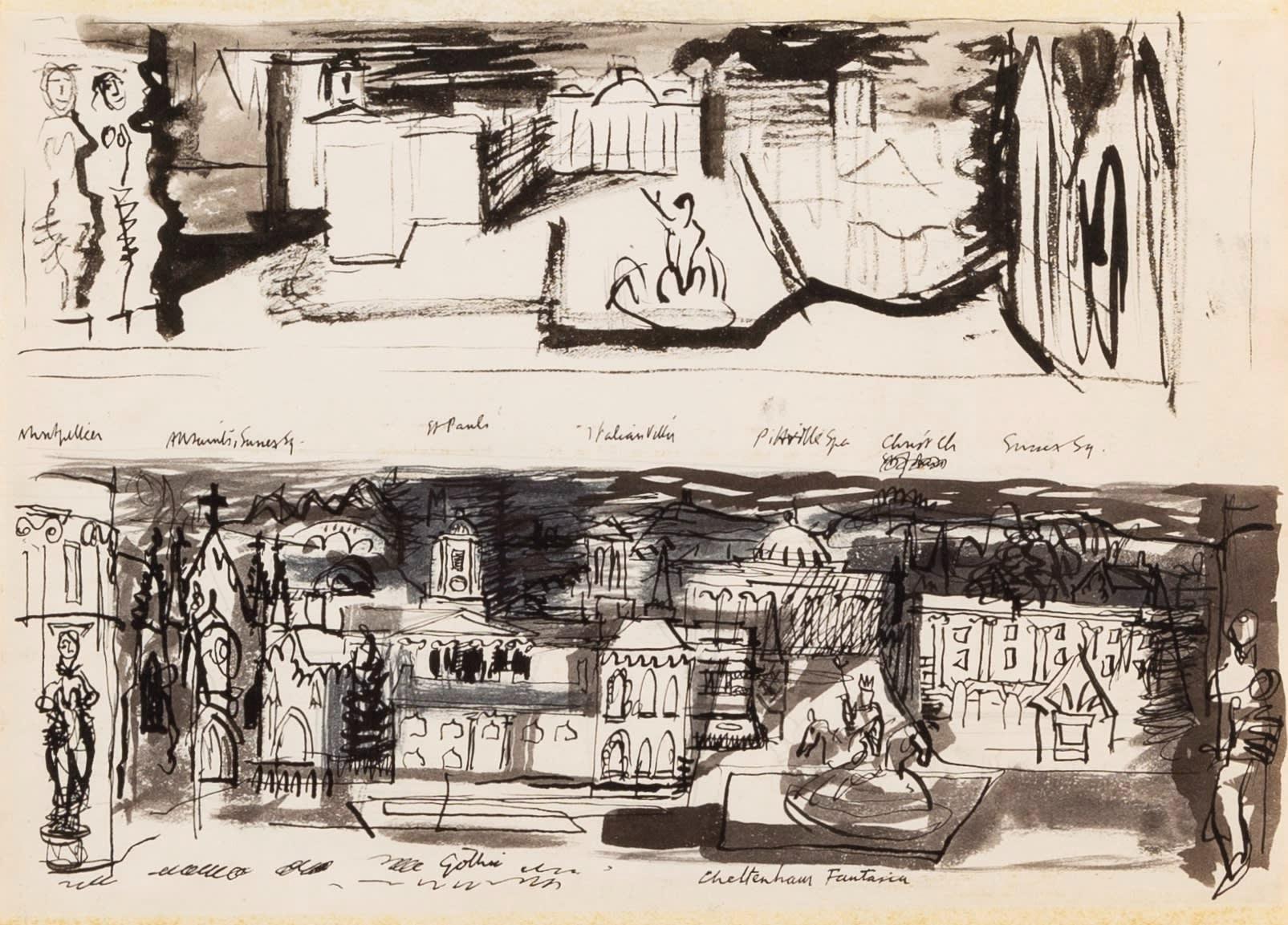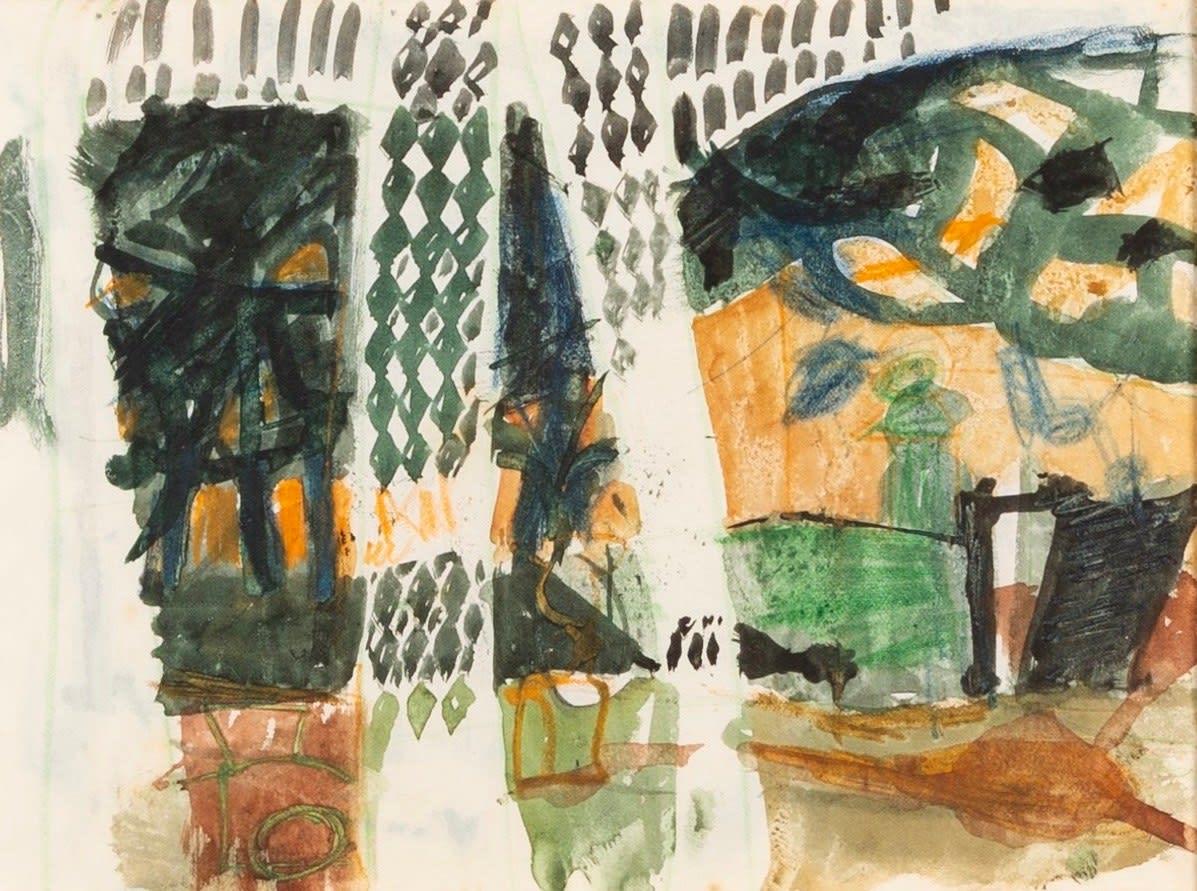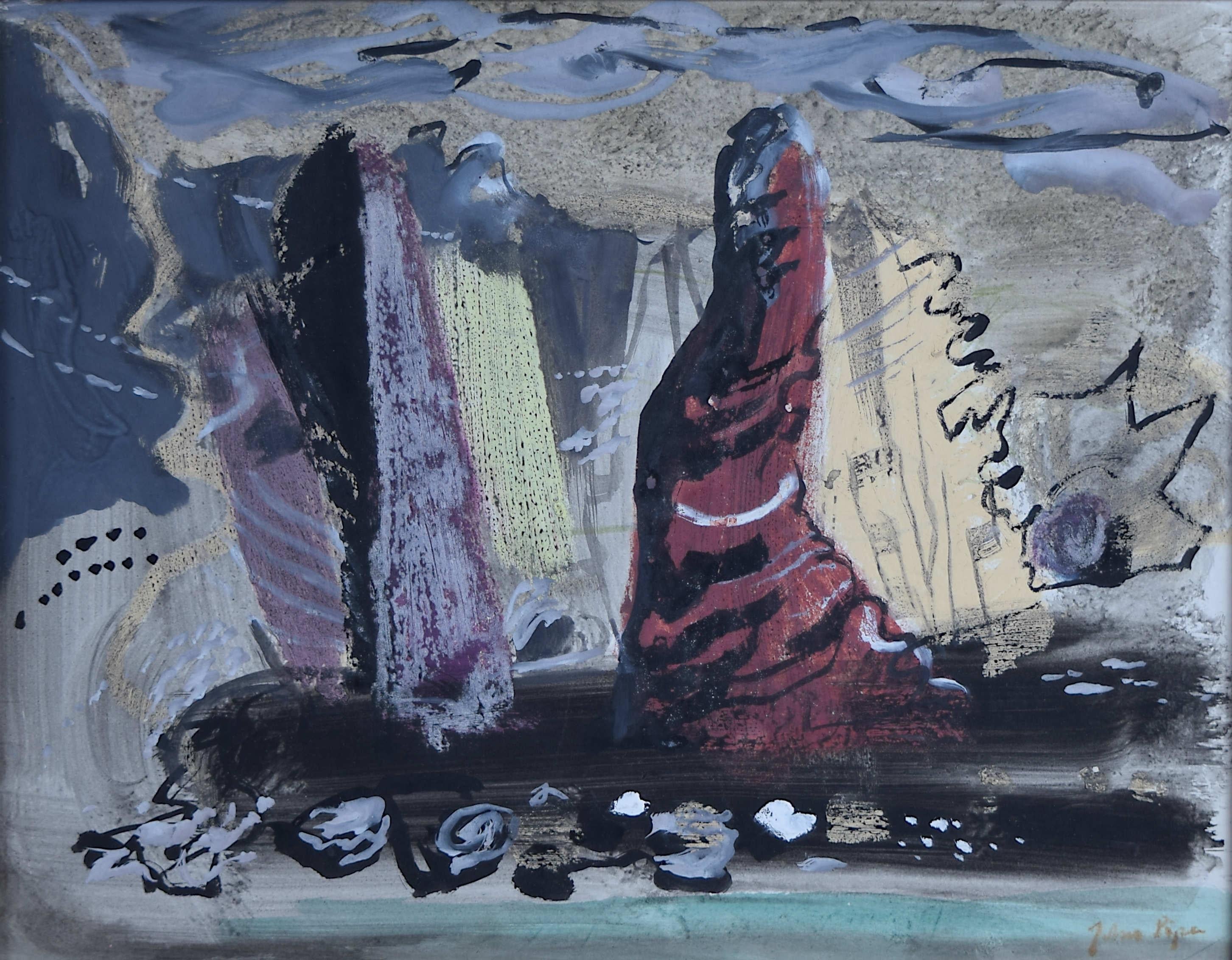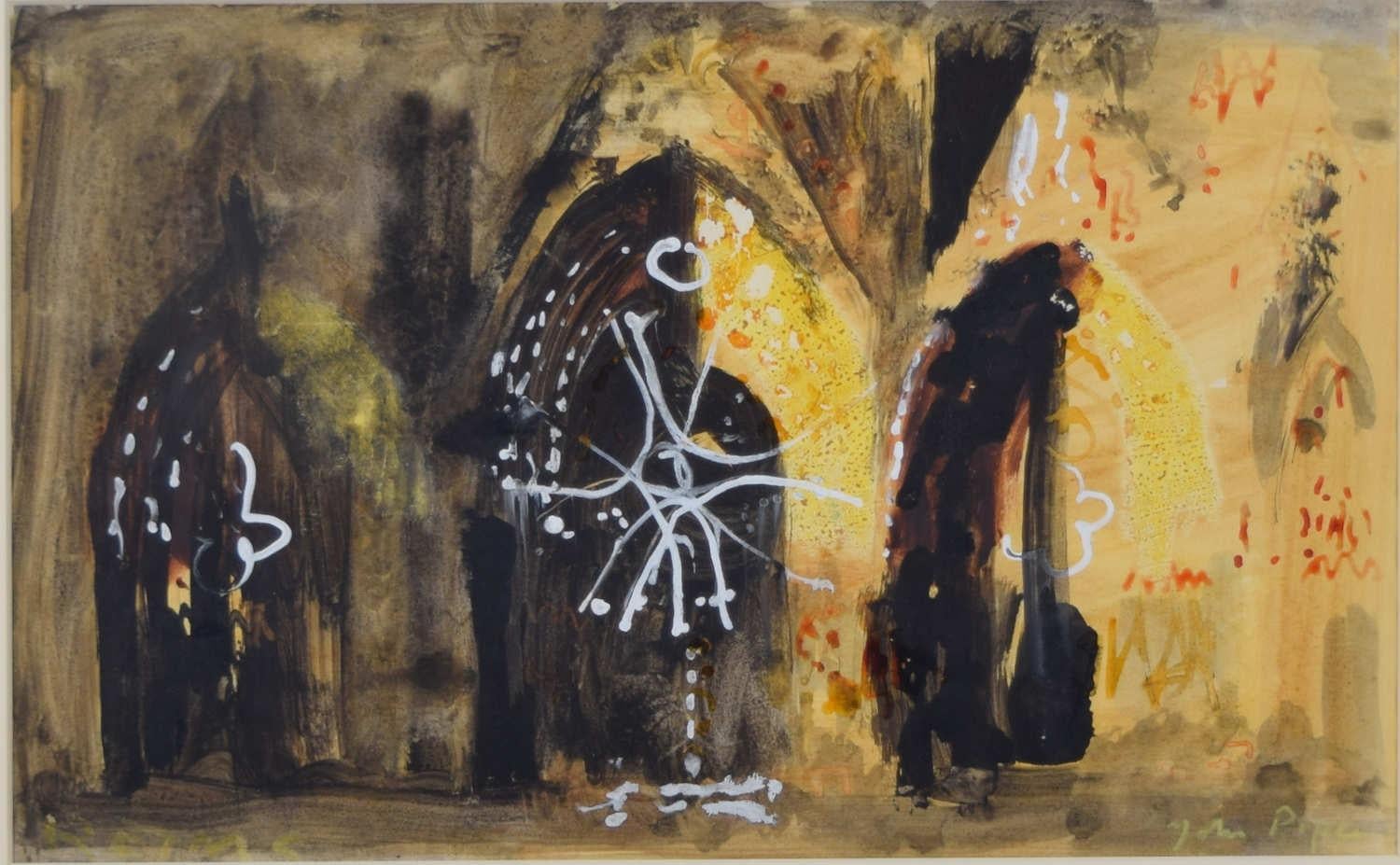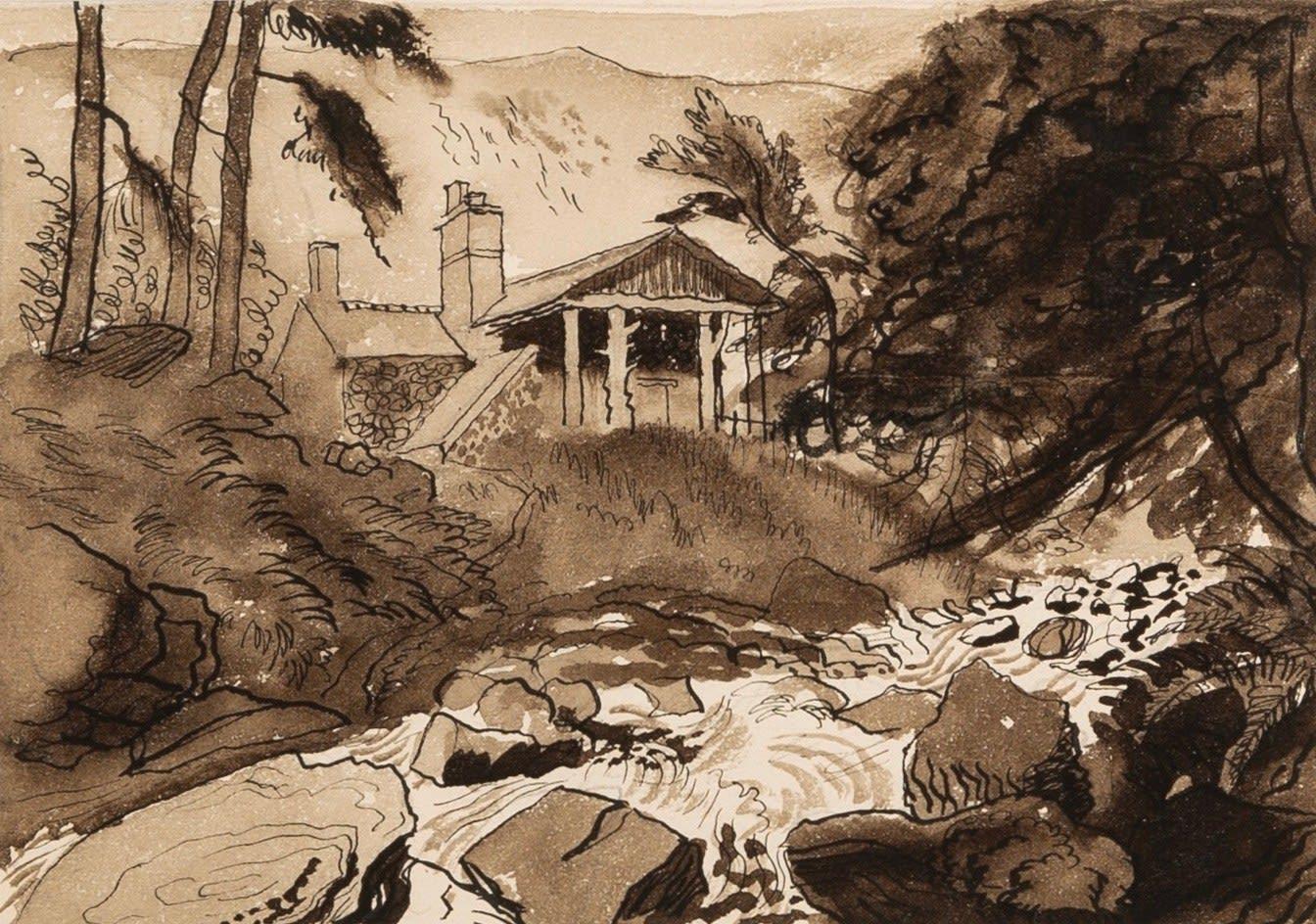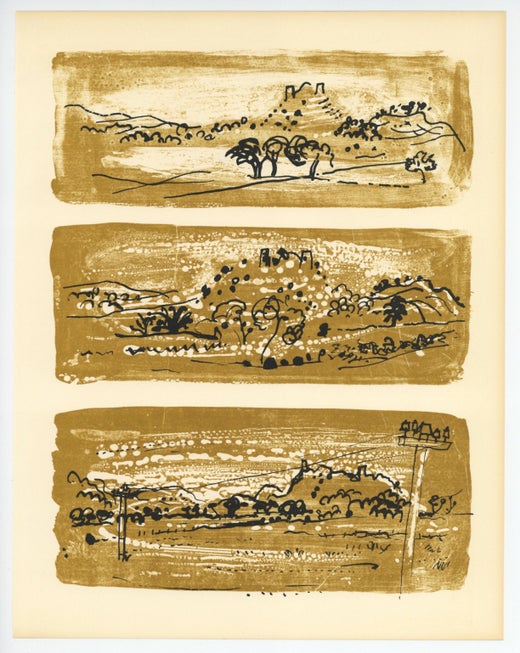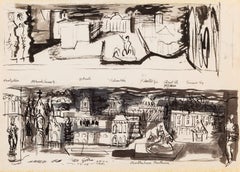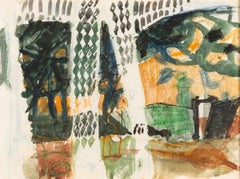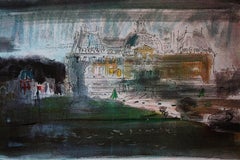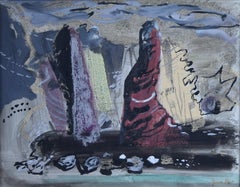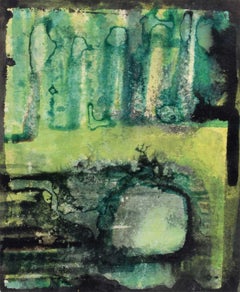Items Similar to Kirby Hall, Northamptonshire, Gouache with Ink and Wash Painting, 1940-42 circa
Want more images or videos?
Request additional images or videos from the seller
1 of 3
John PiperKirby Hall, Northamptonshire, Gouache with Ink and Wash Painting, 1940-42 circa1940-42 circa
1940-42 circa
Price Upon Request
Price Upon Request
Price Upon Request
Price Upon Request
Price Upon Request
Price Upon Request
Price Upon Request
Price Upon Request
Price Upon Request
Price Upon Request
About the Item
Kirby Hall, Northamptonshire, Gouache with Ink and Wash Painting, 1940-42 circa
Additional information:
Medium: Gouache with ink and wash
15.2 x 18.5 cm
6 x 7 1/4 in
As part of an eight-page pamphlet for The Colour of English Country Houses in 1944, Piper included a lovely auto-lithograph of Kirby Hall in Northamptonshire. This work was most likely sketched on the occasion of his visit to the Hall at this time and is of a slightly different angle. It is a working version of the cover of C Aspinall-Oglander's 'Admiral’s Widow’, 1942 (Hogarth Press). The print is cat. no.51.\\\
Piper gives a lovely description of this Elizabethan country house in the introduction to the pamphlet as follows: ‘A yellow stone house of the seventeenth century, in rolling green hunting-country. It gleams in the sun, forms a warm eye-catcher in dull weather and glimmers whitely in moonlight. It is another ruin, partly roofless, and has recently taken over by the Office of Works to be preserved as a show-place.’ (John Piper). Here, Piper, painting at night in the light of the moon, depicts the north front from the inner courtyard, capturing the brilliance of the moonlit night as it dances over the ruins making it in Piper’s own words ‘glimmer whitely’ whilst the dramatic shadows darken the archways and windows.
John Piper was a painter of architecture, landscape and abstract compositions, a designer for the theatre and of stained-glass windows, and a writer on the arts.
Piper was born in 1903 in Epsom, Surrey, the son of a solicitor. Throughout his childhood, he regularly visited Italy, and by 1924 he had published a book of poems and his own illustrations. He worked in his father's office in Westminster until 1928 when he began studying at the Richmond and Kingston Schools of Art. This was followed by two years study at the Royal College of Art. In 1927 he exhibited with David Birch at the Arlington gallery, and in 1931 with Clarice Moffat, P. F. Millard, and his first wife Eileen Holding at the Mansard Gallery in the Heal's store. From 1928 Piper was also contributing towards the Nation.
Piper was a member of the London Group from 1933, and of the Seven and Five Society from 1934 to 1935, exhibiting alongside Henry Moore, Ivon Hitchens, Cedric Morris, Ben and Winifred Nicholson, Christopher Wood, Barbara Hepworth and David Jones. That same year he married Myfanwy Evans, the writer, and for the next two years assisted her on Axis - a Quarterly Review of Contemporary ‘Abstract’ Painting and Sculpture. He began writing for the Architectural Review in 1938, the same year in which he published the first of his popular guidebooks.
In 1938 Piper held his first solo exhibition at the London Gallery where he displayed a collection of his collages and drawings. His early work consisted primarily of landscapes, inspired by his time spent on the south coast with Ben Nicholson, Henry Moore and Ivon Hitchens. His time with these artists and a visit to Paris in 1933, had turned Piper to abstraction. He put these lessons behind him around the time of the onset of the Second World War and focused his energies on representing the British landscape, particularly its architectural subjects. It was around 1939 that Piper first met Sir Osbert Sitwell, who became a great supporter of the artist.
He designed the stage for Stephen Spender's Trial of a Judge in 1938, for the ballets The Quest in 1943 and Job in 1948, and for six operas by Benjamin Britten. Piper was an Official War Artist from 1940 to '42, recording sites which were threatened with bombing such as Windsor Castle, and those which suffered bombing in Coventry, Bath, Bristol and London.
His first international exhibition was at the Buchholz Gallery, New York, in 1948, and he was commissioned to paint decorations for the British Embassy in Rio de Janeiro that same year. International exhibitions followed at Curt Valentin Gallery, New York (1955), Kunstzall Magdalene Sothmann, Amsterdam (1956), Durlacher's, NY (1957), and Gallery Kasahara, Japan (1976).
In 1951 he supervised the design of the Battersea Pleasure Gardens with Osbert Lancaster. He was also commissioned to design the windows for the Chapel at Oundle School in 1954, and the baptistery of the new Coventry Cathedral in 1958.
Between 1963 and '64, Piper produced 'A Retrospect of Churches' in collaboration with his friend John Betjeman, with whom the artist has visited many of the subject churches. Betjeman praised Piper for his love of all architecture: 'He responds to Renaissance monuments ... the originality and sense of scale of the great Victorian architects ... [and] Gothic conventions'.
His work is included in numerous public collections, as well as Deutsche Bank. The inclusion of his work in the Tate's Walk Through British Art was commented on by Alexandra Harris, “There are things that British artists tend to do wonderfully well ... There’s a certain complex, understated colouring that recurs. John Piper thought it was partly about the weather: British eyes are accustomed to seeing things in a certain light. This is simple but makes sense. The great Spanish painters specialise in black shadows and intense light. The British are better at fathoming a thousand varieties of grey and green.”
- Creator:John Piper (1903-1992, British)
- Creation Year:1940-42 circa
- Dimensions:Height: 6 in (15.24 cm)Width: 7.25 in (18.42 cm)
- Medium:
- Period:
- Condition:
- Gallery Location:Kingsclere, GB
- Reference Number:1stDibs: LU2718214575532
John Piper
Born in Epsom, John Egerton Christmas Piper studied at Richmond School of Art and the Royal College of Art from 1926-8. In the mid 1930a, after a visit to Paris, he turned to abstraction. He became a member of the London Group in 1933 and the ‘Seven and Five’ group in 1934-5. During this period he became friends with Oliver Simon of the Curwen Press and his interest in lithography and print making grew. During the Second World War, Piper was appointed as an official war artist recording the effects of the blitz on Britain’s buildings. After the war, he became a Trustee of the Tate and National Galleries and in 1959 he became a member of the Royal Fine Art Commission. Piper is best known for his extensive studies of British architecture and landscape in oil, watercolour and print, and for his photography, stained glass, ceramics, fabric design, murals, stage sets and costume design. His work is held in many Museums and Galleries.
About the Seller
No Reviews Yet
Vetted Professional Seller
Every seller passes strict standards for authenticity and reliability
Established in 2010
1stDibs seller since 2024
41 sales on 1stDibs
Typical response time: 8 hours
- ShippingRetrieving quote...Shipping from: Kingsclere, United Kingdom
- Return Policy
Authenticity Guarantee
In the unlikely event there’s an issue with an item’s authenticity, contact us within 1 year for a full refund. DetailsMoney-Back Guarantee
If your item is not as described, is damaged in transit, or does not arrive, contact us within 7 days for a full refund. Details24-Hour Cancellation
You have a 24-hour grace period in which to reconsider your purchase, with no questions asked.Vetted Professional Sellers
Our world-class sellers must adhere to strict standards for service and quality, maintaining the integrity of our listings.Price-Match Guarantee
If you find that a seller listed the same item for a lower price elsewhere, we’ll match it.Trusted Global Delivery
Our best-in-class carrier network provides specialized shipping options worldwide, including custom delivery.More From This Seller
View AllCheltenham (Fantasia/Panorama), Pen and Ink Painting by John Piper, 1939 circa
By John Piper
Located in Kingsclere, GB
Cheltenham (Fantasia/Panorama), Pen and Ink Painting by John Piper, 1939 circa
Additional information:
Medium: Pen and ink
19 x 26.5 cm
7 1/2 x 10 3/8 in
Inscribed extensively
The upper image closely resembles a 1940 painting, Cheltenham Fantasia, which was sold to a Mr Anderson at the Leicester Galleries in March of that year. The lower image is a study for Piper's 1940 Curwen Press auto-lithograph 'Cheltenham', produced while he was also working on illustrations for the Shell and BP Shilling Guide to Gloucestershire (1939; not used in the project). Betjeman, then head of the project, also used the image to illustrate his article "Book Illustration Can Colour a Whole Town or City" in 'Signature' in 1940. The Cheltenham design is covered and reproduced in Hugh Fowler-Wright's book on Piper.
John Piper was a painter of architecture, landscape and abstract compositions, a designer for the theatre and of stained-glass windows, and a writer on the arts.
Piper was born in 1903 in Epsom, Surrey, the son of a solicitor. Throughout his childhood, he regularly visited Italy, and by 1924 he had published a book of poems and his own illustrations. He worked in his father's office in Westminster until 1928 when he began studying at the Richmond and Kingston Schools of Art. This was followed by two years study at the Royal College of Art. In 1927 he exhibited with David Birch at the Arlington gallery, and in 1931 with Clarice Moffat, P. F. Millard, and his first wife Eileen Holding...
Category
20th Century Abstract Paintings
Materials
Ink
Corsham Court (Garden Structure) Gouache Painting by Peter Potworowski 1952-1957
Located in Kingsclere, GB
Corsham Court (Garden Structure) Gouache Painting by Peter Potworowski 1952-1957
Additional information:
Medium: Gouache
22.5 x 16.5 cm
8 7/8 x 6 1/2 in
Tadeusz Piotr (Peter) Potwo...
Category
20th Century Abstract Paintings
Materials
Gouache
Foot of Pistyll Rhaeadr, Ink and Wash Painting by John Piper, circa 1939-1941
By John Piper
Located in Kingsclere, GB
Foot of Pistyll Rhaeadr, Ink and Wash Painting by John Piper, circa 1939-1941
Additional information:
Medium: Ink and wash
12.5 x 17.7 cm
4 7/8 x 7 in
Titled under the mount
John Piper was a painter of architecture, landscape and abstract compositions, a designer for the theatre and of stained-glass windows, and a writer on the arts.
Piper was born in 1903 in Epsom, Surrey, the son of a solicitor. Throughout his childhood, he regularly visited Italy, and by 1924 he had published a book of poems and his own illustrations. He worked in his father's office in Westminster until 1928 when he began studying at the Richmond and Kingston Schools of Art. This was followed by two years study at the Royal College of Art. In 1927 he exhibited with David Birch at the Arlington gallery, and in 1931 with Clarice Moffat, P. F. Millard, and his first wife Eileen Holding...
Category
20th Century Abstract Paintings
Materials
Ink
Pastoral Landscape, Gouache and Watercolour Painting by Alan Reynolds, 1953
By Alan Reynolds
Located in Kingsclere, GB
Pastoral Landscape, Gouache and Watercolour Painting by Alan Reynolds, 1953
Additional information:
Medium: Gouache and watercolour
19.5 x 27.5 cm
7 5/8...
Category
20th Century Abstract Drawings and Watercolors
Materials
Gouache
Gate, Corsham Court (Blue Sky), Gouache Painting by Peter Potworowski, 1953/55
Located in Kingsclere, GB
Gate, Corsham Court (Blue Sky), Gouache Painting by Peter Potworowski, 1953/55
Additional information:
Medium: Gouache
23.5 x 33 cm
9 1/4 x 13 in
Tadeusz Piotr (Peter) Potworowski ...
Category
20th Century Abstract Paintings
Materials
Gouache
On the Meldons Road, Watercolour Painting by William George Gillies, circa 1940s
Located in Kingsclere, GB
On the Meldons Road, Watercolour Painting by William George Gillies, circa 1940s
Additional information:
Medium: Watercolour
41.5 x 59 cm
16 3/8 x 23 1/4 in
Signed
William George G...
Category
20th Century Landscape Drawings and Watercolors
Materials
Watercolor
You May Also Like
Twentieth Century Limited Edition Screen Print Vaux-Le-Vicomte, French Chateau
By John Piper CH
Located in ludlow, GB
Twentieth Century Limited Edition Screen Print entitled Vaux-Le-Vicomte, depicting a beautiful French Chateau.
Vaux-le-Vicomte a Screenprint by another of Wales's most famous sons...
Category
Late 20th Century Abstract Landscape Prints
Materials
Screen
John Piper Bullslaughter Bay c. 1955 Pembrokeshire abstract watercolour painting
By John Piper
Located in London, GB
John Piper (1903-1992)
Bullslaughter Bay
Watercolour, gouache and pastel on paper
27.5 x 35.5cm
John Piper CH was an English painter, printmaker, and designer of stained-glass windo...
Category
1950s Abstract Landscape Drawings and Watercolors
Materials
Pastel, Watercolor, Gouache
John Piper Reims Cathedral, France watercolour/gouache/ink c.1960
By John Piper CH
Located in London, GB
To see our other Modern British Art, scroll down to "More from this Seller" and below it click on "See all from this seller" - or send us a message if you cannot find the artist you ...
Category
1960s Impressionist Landscape Drawings and Watercolors
Materials
Watercolor, Gouache, Ink
John Piper: Study for the Piper Building mural gouache 1962/3
By John Piper CH
Located in London, GB
To see our other Modern British Art, scroll down to "More from this Seller" and below it click on "See all from this seller" - or send us a message if you cannot find the artist you ...
Category
1960s Impressionist Landscape Drawings and Watercolors
Materials
Oil, Gouache
Façade lithograph by John Piper Modern British Art William Walton Eaton Hall
By John Piper CH
Located in London, GB
To see our other Modern British Art, scroll down to "More from this Seller" and below it click on "See all from this seller" - or send us a message if you cannot find the artist you want.
John Piper (1903 - 1992)
Façade (1987)
Lithograph
45 x 60 cm
Numbered 96/108 lower left and signed lower right, both in pencil. Printed by Piper and the screenprinter Chris Prater in 1987 after the original designs from 1942.
'Façade' was a sequence of poems written by the English poet Edith Sitwell. They were set to music by William Walton in 1922, four years after they were first written. 'Façade' premiered in 1923 in London, and was praised for its experimental modernist style. The choreographer Frederick Ashton made Façade into a ballet in 1931; Sitwell did not wish her poems to be included, but Walton's orchestral arrangements were used.
John Piper was commissioned as set designer for a 1942 performance of Facade. This lithograph is the design for the performance's curtain; the poetry and music of the performance were played behind the curtain, unseen by the audience. The Gothic house to the right was inspired by Eaton Hall...
Category
1970s Prints and Multiples
Materials
Lithograph
Newchurch, Romney Marsh watercolour by John Piper
By John Piper CH
Located in London, GB
To see our other Modern British Art, scroll down to "More from this Seller" and below it click on "See all from this seller" - or send us a message if you cannot find the artist you ...
Category
1980s Drawings and Watercolor Paintings
Materials
Watercolor
